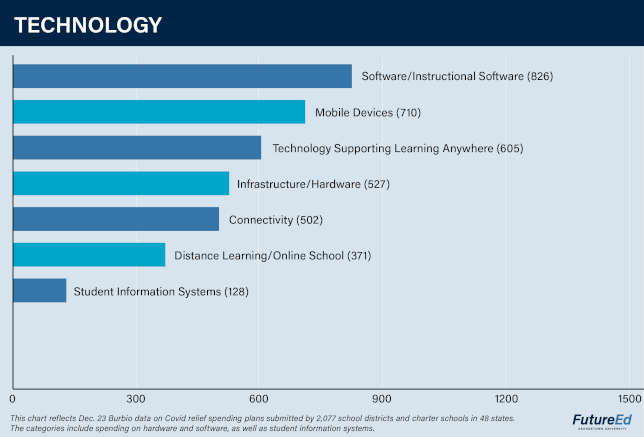Teacher Hiring and Pay, Summer Learning and HVAC Top Uses for ESSER III Funds
- By Dian Schaffhauser
- 01/13/22
An analysis
by Future-Ed
found that most K-12 districts are spending at least some portion of
their federal relief funding in a few categories: hiring or paying
raises or bonuses to teachers and counselors; running summer learning
programs; and upgrades tied to heating, ventilation and air
conditioning.
The project examined
the planned allocations for about a third of the $122 billion in
Elementary and Secondary School Emergency Relief (ESSER III) funds
made available under the American
Rescue Plan. Future-Ed worked with Burbio,
a data service known for its tracking of school openings. Burbio
examined publicly available details of spending plans developed by
2,100 districts and charter school organizations, representing the
10% of districts and schools attended by some 40% of all
public-school students in the United States. The planned expenditures
were sorted into more than 100 categories.

While technology
expenditures may not show up on a majority of K-12 spending plans for federal relief funds, improvements in student device access and
internet connectivity are still drawing the attention of a number of school districts. Source: FutureEd
As the reporting
explained, the districts and charters have "wide latitude"
in using the ESSER III funds, as long as the spending is focused on
"reopening schools safely and helping students recover from the
pandemic." The act requires that states monitor their local
spending.
In the category of
staffing, teachers and counselors topped the list, with 1,164
district plans citing planned spending in that category. That was
followed by "professional development, referenced in 883
spending plans.
Academic recovery
included summer learning, mentioned in 1,125 plans, instructional
materials (784) and afterschool or extended day (733).
Top contenders in
the category of climate systems were HVAC, designated in 1,090 plans,
and personal protective equipment (736).
Technology also
continues to draw investment. Planned spending on tech included:
-
Software and
instructional software, listed in 826 plans;
-
Student mobile
devices (710);
-
Technology to
support learning from anywhere (605);
-
Infrastructure
and hardware (527);
-
Connectivity
(502);
-
Distance
learning and online school (371); and
-
Student
information systems (128).
While cybersecurity
wasn't broken out as a separate category in the analysis that was
made publicly available, some notable investments are headed that
way. The report noted that Miami-Dade
County Public Schools, for instance, was expected to
spend some $30 million on cybersecurity-related expenses, after a
year in which the Florida district has suffered "more
than a dozen distributed denial of service attacks"
(many of which were instigated by a high schooler attending school in
the district).
The report made sure
to reference some of the less obvious ways districts hoped to
allocate federal largesse, such as the Texas
district that intends to spend $171,000 on band
instruments and the Wisconsin
district that hopes to buy a 3D cadaver table for a
high school anatomy course. And, Future-Ed pointed out, 27 local
education agencies - just over 1% -- proposed spending a portion of
their relief funds on athletics.
The detailed rundown
on K-12 spending trends is openly available on
the Future-Ed website.
About the Author
Dian Schaffhauser is a former senior contributing editor for 1105 Media's education publications THE Journal, Campus Technology and Spaces4Learning.